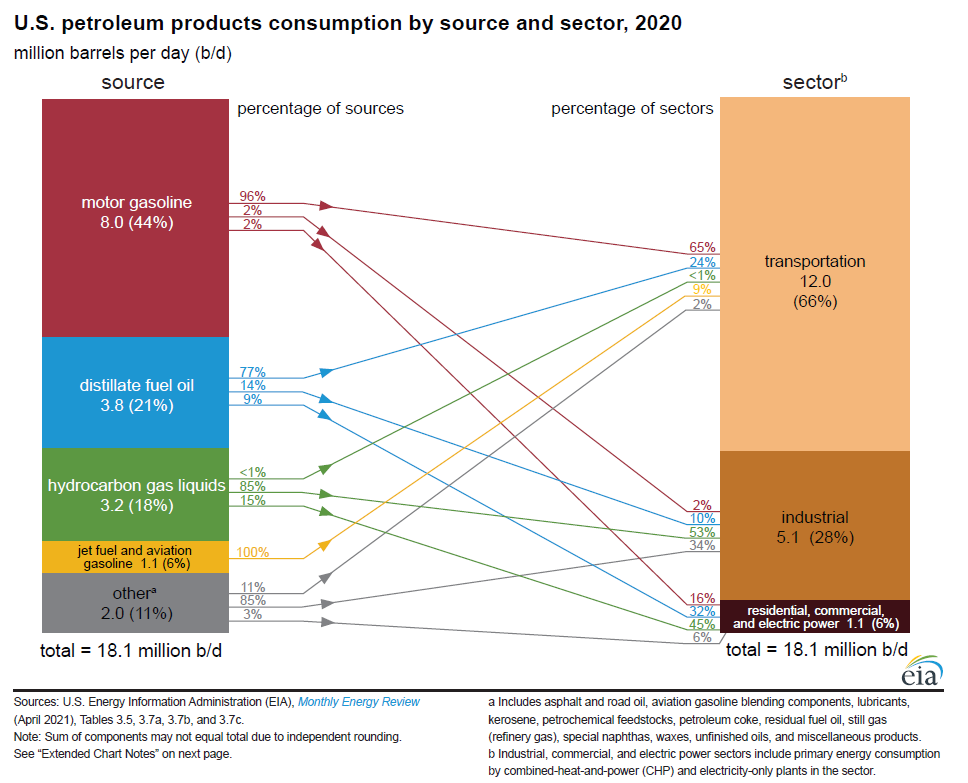Oil and petroleum products explained Use of oil
Oil and petroleum products explained Use of oil
Crude oil and other liquids produced from fossil fuels are refined into petroleum products that people use for many different purposes. Biofuels are also used as petroleum products, mainly in mixtures with gasoline and diesel fuel.
Petroleum has historically been the largest major energy source for total annual U.S. energy consumption. We use petroleum products to propel vehicles, to heat buildings, and to produce electricity. In the industrial sector, the petrochemical industry uses petroleum as a raw material (a feedstock) to make products such as plastics, polyurethane, solvents, and hundreds of other intermediate and end-user goods.
In 2020, U.S. petroleum consumption averaged about 18.12 million barrels per day (b/d), which included nearly 1 million b/d of biofuels.1 U.S. total petroleum consumption was about 13% lower in 2020 than the levels in 2018 and 2019 largely because of responses to the COVID-19 pandemic. Consumption of most petroleum products in 2020 was lower than in 2019.
- U.S. petroleum consumption by end-use sectors' percentage share of total in 20202
- Transportation 66%
- Industrial 28%
- Residential 3%
- Commercial 2%
- Electric power <1%
What are the petroleum products people consume most?
Gasoline is the most consumed petroleum product in the United States. In 2020, consumption of finished motor gasoline averaged about 8.03 million b/d (337 million gallons per day), which was equal to about 44% of total U.S. petroleum consumption.
Distillate fuel oil is the second most-consumed petroleum product in the United States. Distillate fuel oil includes diesel fuel and heating oil. Diesel fuel is used in the diesel engines of heavy construction equipment, trucks, buses, tractors, boats, trains, some automobiles, and electricity generators. Heating oil, also called fuel oil, is used in boilers and furnaces for heating homes and buildings, for industrial heating, and for producing electricity in power plants. Total distillate fuel oil consumption in 2020 averaged about 3.78 million b/d (159 million gallons per day), equal to 21% of total U.S. petroleum consumption.
Hydrocarbon gas liquids (HGLs), the third most-used category of petroleum in the United States, include propane, ethane, butane, and other HGLs that are produced at natural gas processing plants and oil refineries. HGLs have many uses. Total consumption of HGLs in 2020 averaged about 3.20 million b/d, accounting for about 18% of total petroleum consumption.
Jet fuel is the fourth most-used petroleum product in the United States. Jet fuel consumption averaged about 1.08 million b/d (45 million gallons per day) in 2020, accounting for about 6% of total petroleum consumption.
| Product | Annual consumption (million barrels per day) |
|---|---|
| Finished motor gasoline1 | 8.034 |
| Distillate fuel oil (diesel fuel and heating oil)1 | 3.776 |
| Hydrocarbon gas liquids (HGLs) | 3.197 |
| Kerosene-type jet fuel | 1.078 |
| Still gas | 0.611 |
| Asphalt and road oil | 0.342 |
| Petrochemical feedstocks | 0.286 |
| Petroleum coke | 0.260 |
| Residual fuel oil | 0.217 |
| Miscellaneous products and other liquids2 | 0.152 |
| Lubricants | 0.100 |
| Special napthas | 0.045 |
| Aviation gasoline | 0.011 |
| Kerosene | 0.008 |
| Waxes | 0.004 |
| Total petroleum products | 18.120 |
|
1 Includes fuel ethanol in gasoline and biodiesel in distillate fuels. |
|
How much petroleum does the world consume?
Total world consumption of petroleum in 2018 was about 100 million b/d.
- The five largest petroleum-consuming countries in 2018 and their shares of total world petroleum consumption
- United States20.5%
- China13.9%
- India4.8%
- Japan3.8%
- Russia3.6%
What is the outlook for U.S. petroleum consumption?
The U.S. Energy Information Administration projects in the Annual Energy Outlook 2021 Reference case, that total U.S. liquid fuels (petroleum and other liquids) use will return to the levels of consumption in 2018 and 2019 by 2036 and increase gradually during the remainder of the projection period to nearly 22 million b/d in 2050. Liquid fuels will account for about 36% to 38% of total annual U.S. energy consumption through 2050.
Also in the Reference case, liquid fuels continue as the main energy source for the transportation sector, but the percentage share falls slightly from 96% in 2020 to 92% in 2050. The volume of total transportation sector liquid fuels consumption is projected to be about the same in 2050 as in 2022.
1 U.S. Energy Information Administration, Petroleum Supply Monthly, February 2021, preliminary data for 2020.
2 U.S. Energy Information Administration, Monthly Energy Review, March 2021, preliminary data for 2020.
Last updated: May 10, 2021

Comments
Post a Comment